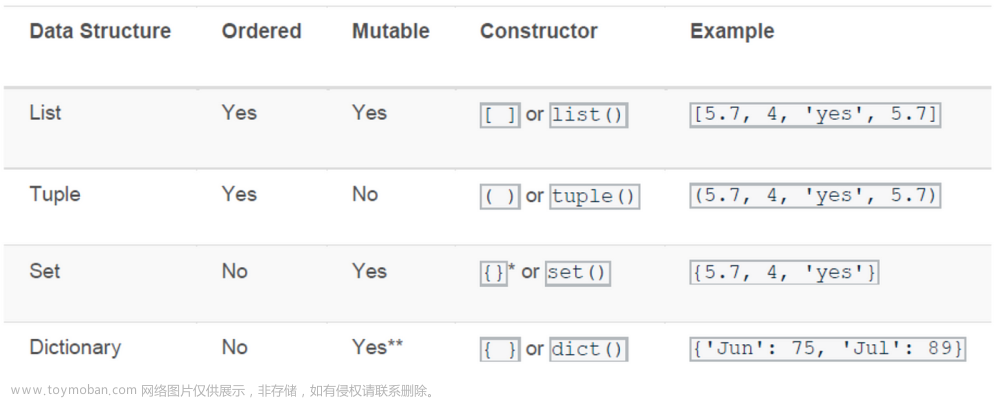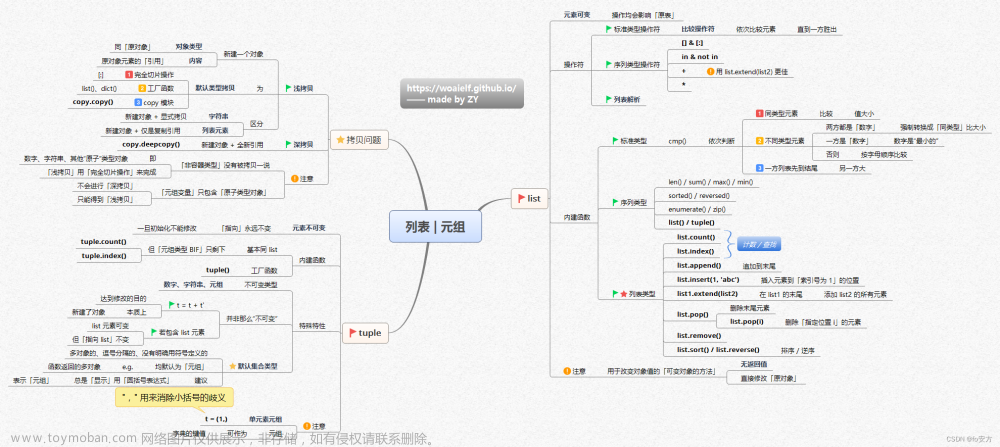高级数据结构 Trie树(字典树)
(Trie Tree)字典树_Rkun18的博客-CSDN博客
字典树节点表示
#define TRIE_MAX_CHAR_NUM 26
//这里你可以自由设置 根据不同需求设置 如果有大小或者其他符号你就需要增大这个数字
struct TrieNode{
TrieNode *child[TRIE_MAX_CHAR_NUM];
bool isEnd;
TrieNode():isEnd(false){
for (int i = 0; i < TRIE_MAX_CHAR_NUM; ++i) {
child[i]=0;
}
}
};
构造字典树
这里使用维基百科里的一幅图举例,由于只是举例,使用较小的26个字母,把大小写统一规定成小写,图里’A’变成’a’,方便构造树

int main() {
TrieNode root;//根
TrieNode n1,n2,n3;//树的第一层
root.child['t'-'a']=&n1;
root.child['a'-'a']=&n2;
root.child['i'-'a']=&n3;
n2.isEnd= true;//单个字符串走到末尾
n3.isEnd= true;
TrieNode n4,n5,n6;//第二层
n1.child['o'-'a']=&n4;
n4.isEnd= true;
n1.child['e'-'a']=&n5;
n3.child['n'-'a']=&n6;
n6.isEnd= true;
TrieNode n7,n8,n9,n10;//最后一层
n5.child['a'-'a']=&n7;
n7.isEnd= true;
n5.child['d'-'a']=&n8;
n8.isEnd= true;
n5.child['n'-'a']=&n9;
n9.isEnd= true;
n6.child['n'-'a']=&n10;
n10.isEnd= true;
preorder(&root,0);//先序遍历
return 0;
}
先序遍历
void preorder(TrieNode *node,int layer){
for (int i = 0; i < TRIE_MAX_CHAR_NUM; ++i) {
if(node->child[i]){
for (int j = 0; j <layer ; ++j) {
printf("-");
}
printf("%c",i+'a');
if(node->child[i]->isEnd){
printf("[done]");
}
printf("\n");
preorder(node->child[i],layer+1);
}
}
}
main方法运行:
a[done]
i[done]
-n[done]
--n[done]
t
-e
--a[done]
--d[done]
--n[done]
-o[done]
Trie获取所有单词
-
深度搜索trie树,对于正在搜索的节点node
-
遍历该节点的所有孩子指针child[i],如果指针不为空,将child[i]对应字符放入栈里
-
如果孩子指针isEnd为真,从栈底到栈顶对栈遍历,生成字符串,将它保存至结果数组中去
-
深度搜索child[i]
-
弹出栈顶字符
void get_all_word(TrieNode *node, string &word, vector<string> &wordList) {
for (int i = 0; i < TRIE_MAX_CHAR_NUM; ++i) {
if (node->child[i]) {
word.push_back((char) i + 'a');//字符入栈
if (node->child[i]->isEnd) {
wordList.push_back(word);
}
get_all_word(node->child[i], word, wordList);
word.erase(word.length() - 1, 1);//弹出栈顶字符
}
}
}
int main() {
TrieNode root;//根
TrieNode n1, n2, n3;//树的第一层
root.child['t' - 'a'] = &n1;
root.child['a' - 'a'] = &n2;
root.child['i' - 'a'] = &n3;
n2.isEnd = true;//单个字符串走到末尾
n3.isEnd = true;
TrieNode n4, n5, n6;//第二层
n1.child['o' - 'a'] = &n4;
n4.isEnd = true;
n1.child['e' - 'a'] = &n5;
n3.child['n' - 'a'] = &n6;
n6.isEnd = true;
TrieNode n7, n8, n9, n10;//最后一层
n5.child['a' - 'a'] = &n7;
n7.isEnd = true;
n5.child['d' - 'a'] = &n8;
n8.isEnd = true;
n5.child['n' - 'a'] = &n9;
n9.isEnd = true;
n6.child['n' - 'a'] = &n10;
n10.isEnd = true;
vector<string> wordList;
string word = "";
get_all_word(&root, word, wordList);
for (int i = 0; i < wordList.size(); ++i) {
cout << wordList[i] << endl;
}
return 0;
}
a
i
in
inn
tea
ted
ten
to
整体功能
class Trie{
public:
Trie(){
}
~Trie(){
for (int i = 0; i <_node_vec.size() ; ++i) {
delete _node_vec[i];
}
} //插入
void insert(const char *word){
}//查找
bool search(const char *word){
}//是否有以某个字符串为前缀的
bool startsWith(const char *prefix){
}
TrieNode *root(){
return &_root;
}
private:
TrieNode *newNode(){
TrieNode *node=new TrieNode();
_node_vec.push_back(node);
return node;
}
vector<TrieNode *>_node_vec;
TrieNode _root;
};
插入
-
使用指针ptr指向root
-
逐个遍历待插入字符串中的各个字符
-
计算下标pos=’正在遍历字符’-‘a’
-
如果ptr指向第pos孩子为假:
-
创建该节点第pos个孩子
-
ptr指向该节点的第pos个孩子
-
标记ptr指向节点的isEnd为true
void insert(const char *word){
TrieNode *ptr=&_root;
while (*word){
int pos=*word-'a';
if(!ptr->child[pos]){
ptr->child[pos]=newNode();
}
ptr=ptr->child[pos];
word++;
}
ptr->isEnd= true;
}
搜索
-
使用ptr指针指向root
-
逐个遍历带搜索字符各个字符
-
计算下标pos=’正在遍历字符’-‘a’
-
如果ptr指向节点第pos个孩子为假:返回假
-
ptr指向第pos个孩子
-
返回ptr指向节点的isEnd
bool search(const char *word){
TrieNode *ptr=&_root;
while (*word){
int pos=*word-'a';
if(!ptr->child[pos]){
return false;
}
ptr=ptr->child[pos];
word++;
}
return ptr->isEnd;
}
判断前缀是否存在
bool startsWith(const char *prefix){
TrieNode *ptr=&_root;
while (*prefix){
int pos=*prefix-'a';
if(!ptr->child[pos]){
return false;
}
ptr=ptr->child[pos];
prefix++;
}
return true;
}
前缀树代码
class Trie{
public:
Trie(){
}
~Trie(){
for (int i = 0; i <_node_vec.size() ; ++i) {
delete _node_vec[i];
}
}
void insert(const char *word){
TrieNode *ptr=&_root;
while (*word){
int pos=*word-'a';
if(!ptr->child[pos]){
ptr->child[pos]=newNode();
}
ptr=ptr->child[pos];
word++;
}
ptr->isEnd= true;
}
bool search(const char *word){
TrieNode *ptr=&_root;
while (*word){
int pos=*word-'a';
if(!ptr->child[pos]){
return false;
}
ptr=ptr->child[pos];
word++;
}
return ptr->isEnd;
}
bool startsWith(const char *prefix){
TrieNode *ptr=&_root;
while (*prefix){
int pos=*prefix-'a';
if(!ptr->child[pos]){
return false;
}
ptr=ptr->child[pos];
prefix++;
}
return true;
}
TrieNode *root(){
return &_root;
}
private:
TrieNode *newNode(){
TrieNode *node=new TrieNode();
_node_vec.push_back(node);
return node;
}
vector<TrieNode *>_node_vec;
TrieNode _root;
};
测试
int main() {
Trie trie;
trie.insert("hello");
trie.insert("echo");
trie.insert("eleven");
trie.insert("how");
cout<<"preorder_trie:"<<endl;
preorder(trie.root(),0);
vector<string>ls;
string word;
cout<<"All words:"<<endl;
get_all_word(trie.root(),word,ls);
for (int i = 0; i < ls.size(); ++i){
cout<<ls[i]<<endl;
}
cout<<"Search:"<<endl;
printf("hello :%d\n",trie.search("hello"));
printf("hel :%d\n",trie.search("hel"));
cout<<"StartsWith:"<<endl;
printf("hello :%d\n",trie.startsWith("hello"));
printf("hel :%d\n",trie.startsWith("hel"));
return 0;
}
e
-c
--h
---o[done]
-l
--e
---v
----e
-----n[done]
h
-e
--l
---l
----o[done]
-o
--w[done]
All words:
echo
eleven
hello
how
Search:
hello :1
hel :0
StartsWith:
hello :1
hel :1
208. 实现 Trie (前缀树)
力扣
直接使用Trie类,改个名,调用方法把string通过c_str(),变成字符数组
#define TRIE_MAX_CHAR_NUM 26
//这里你可以自由设置 根据不同需求设置 如果有大小或者其他符号你就需要增大这个数字
struct TrieNode{
TrieNode *child[TRIE_MAX_CHAR_NUM];
bool isEnd;
TrieNode():isEnd(false){
for (int i = 0; i < TRIE_MAX_CHAR_NUM; ++i) {
child[i]=0;
}
}
};
using namespace std;
class Trie1{
public:
Trie1(){
}
~Trie1(){
for (int i = 0; i <_node_vec.size() ; ++i) {
delete _node_vec[i];
}
}
void insert(const char *word){
TrieNode *ptr=&_root;
while (*word){
int pos=*word-'a';
if(!ptr->child[pos]){
ptr->child[pos]=newNode();
}
ptr=ptr->child[pos];
word++;
}
ptr->isEnd= true;
}
bool search(const char *word){
TrieNode *ptr=&_root;
while (*word){
int pos=*word-'a';
if(!ptr->child[pos]){
return false;
}
ptr=ptr->child[pos];
word++;
}
return ptr->isEnd;
}
bool startsWith(const char *prefix){
TrieNode *ptr=&_root;
while (*prefix){
int pos=*prefix-'a';
if(!ptr->child[pos]){
return false;
}
ptr=ptr->child[pos];
prefix++;
}
return true;
}
TrieNode *root(){
return &_root;
}
private:
TrieNode *newNode(){
TrieNode *node=new TrieNode();
_node_vec.push_back(node);
return node;
}
vector<TrieNode *>_node_vec;
TrieNode _root;
};
class Trie {
public:
Trie() {
}
void insert(string word) {
trie.insert(word.c_str());
}
bool search(string word) {
return trie.search(word.c_str());
}
bool startsWith(string prefix) {
return trie.startsWith(prefix.c_str());
}
private:
Trie1 trie;
};
/**
* Your Trie object will be instantiated and called as such:
* Trie* obj = new Trie();
* obj->insert(word);
* bool param_2 = obj->search(word);
* bool param_3 = obj->startsWith(prefix);
*/
211. 添加与搜索单词 - 数据结构设计
力扣
这里考虑搜索遇到’.'如何
-
当遍历到单词结束时
-
如果node指向的节点标记为单词的结尾(isEnd==true)返回真,否则返回假
-
如果word遇到’.’
-
遍历所有node的孩子指针,继续递归搜索,单词指针向前移动一个位置,如果递归搜索结果为真,返回真
-
如果不是’.’
-
计算孩子位置pos,pos指向当前孩子为真,继续深搜,指针向前移动一个位置,如果搜索结果为真,返回真文章来源:https://www.toymoban.com/news/detail-430451.html
下面来改写这个search方法文章来源地址https://www.toymoban.com/news/detail-430451.html
#define TRIE_MAX_CHAR_NUM 26
//这里你可以自由设置 根据不同需求设置 如果有大小或者其他符号你就需要增大这个数字
struct TrieNode {
TrieNode *child[TRIE_MAX_CHAR_NUM];
bool isEnd;
TrieNode() : isEnd(false) {
for (int i = 0; i < TRIE_MAX_CHAR_NUM; ++i) {
child[i] = 0;
}
}
};
class Trie {
public:
Trie() {
}
~Trie() {
for (int i = 0; i < _node_vec.size(); ++i) {
delete _node_vec[i];
}
}
void insert(const char *word) {
TrieNode *ptr = &_root;
while (*word) {
int pos = *word - 'a';
if (!ptr->child[pos]) {
ptr->child[pos] = newNode();
}
ptr = ptr->child[pos];
word++;
}
ptr->isEnd = true;
}
bool search_tire(TrieNode *node, const char *word) {
if (*word == '\0') {
if (node->isEnd) {
return true;
}
return false;
}
if (*word == '.') {
for (int i = 0; i < TRIE_MAX_CHAR_NUM; ++i) {
if (node->child[i] && search_tire(node->child[i], word + 1)) {
return true;
}
}
} else {
int pos = *word - 'a';
if (node->child[pos] && search_tire(node->child[pos], word + 1)) {
return true;
}
}
return false;
}
bool startsWith(const char *prefix) {
TrieNode *ptr = &_root;
while (*prefix) {
int pos = *prefix - 'a';
if (!ptr->child[pos]) {
return false;
}
ptr = ptr->child[pos];
prefix++;
}
return true;
}
TrieNode *root() {
return &_root;
}
private:
TrieNode *newNode() {
TrieNode *node = new TrieNode();
_node_vec.push_back(node);
return node;
}
vector<TrieNode *> _node_vec;
TrieNode _root;
};
class WordDictionary {
public:
WordDictionary() {
}
void addWord(string word) {
trie.insert(word.c_str());
}
bool search(string word) {
return trie.search_tire(trie.root(),word.c_str());
}
private:
Trie trie;
};
/**
* Your WordDictionary object will be instantiated and called as such:
* WordDictionary* obj = new WordDictionary();
* obj->addWord(word);
* bool param_2 = obj->search(word);
*/
到了这里,关于高级数据结构 Trie树(字典树)的文章就介绍完了。如果您还想了解更多内容,请在右上角搜索TOY模板网以前的文章或继续浏览下面的相关文章,希望大家以后多多支持TOY模板网!












